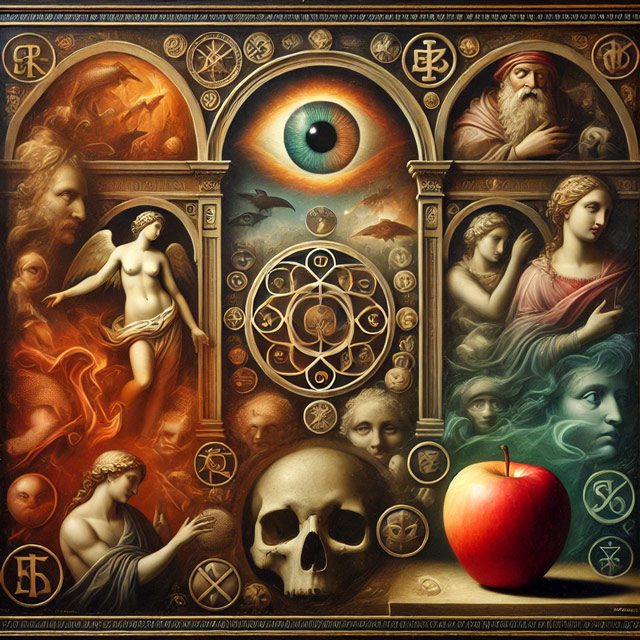

Art speaks a language all its own. Sometimes, the messages are as clear as day, but often, they are wrapped in layers of mystery, symbolism, and hidden meaning. For centuries, artists have woven hidden messages into their works, using symbols that speak louder than words. These symbols often reflect the culture, religion, or politics of their time, but they can also carry secret meanings—ones that only a few understand. In this article, we’ll explore the lesser-known and often controversial meanings behind symbols in art, from ancient times to the present day.
What makes a symbol “secret”? Is it something that artists hide intentionally? Or is it simply that we’ve lost touch with the deeper meanings behind certain images? Let’s dive into the secrets of art symbols that no one wants to talk about—or at least not openly.
What Makes a Symbol “Secret”?
When we talk about “secret” symbols in art, we’re not always referring to something conspiratorial. Sometimes, the meanings of symbols change over time, or they fade from collective memory. In other cases, certain symbols are deliberately downplayed or suppressed because they make people uncomfortable. A symbol may start as something universal, but with changing times and shifting societies, its meaning gets lost—or worse, twisted.
One way a symbol becomes “secret” is when it goes against the dominant culture of the time. For instance, a symbol that challenges authority or criticizes religion might be hidden or downplayed in art to avoid controversy. The artist may include it, but in a subtle way, so that only a few viewers catch the hidden meaning.
Another reason symbols remain secret is that they belong to subcultures or groups outside the mainstream. Religious sects, secret societies, or even political movements often use symbols as a form of coded communication. If you don’t belong to the group, you might miss the entire meaning behind the symbol. What’s fascinating about these secret symbols is that they hide in plain sight, waiting for the right observer to uncover them.
Sometimes, it’s simply a matter of time. Symbols that meant something specific centuries ago may now be interpreted in completely different ways. As our world evolves, so do the meanings of the symbols we use in art. What once was considered a sacred or powerful symbol could now be seen as a mere decorative element. That’s why it’s important to understand the history and culture behind the symbols in art—because they might reveal more than you’d think.
Religious Symbols with Hidden Layers
Religion has always been a major source of symbolism in art. Christian art, in particular, is filled with imagery that has layers upon layers of meaning. For example, the Ichthys, or the fish symbol, was once a secret code for early Christians to identify each other. In its simplest form, it represents Jesus Christ, but over time, it became just another religious symbol we see in churches or on bumper stickers. The deeper meaning of the Ichthys—its origins as a secret sign of faith—has largely faded from public awareness.
The lamb is another powerful symbol in Christian art. On the surface, it represents purity and sacrifice. But it also refers to Jesus as the “Lamb of God.” This dual meaning—both innocent and sacrificial—gives the lamb a deeper, more complex significance in religious paintings. Artists have often used the lamb to evoke a sense of peace, but also to subtly hint at themes of death and salvation.
What many people don’t realize is that many Christian symbols actually have pagan roots. For example, the halo, which is commonly seen in religious paintings of saints and angels, can be traced back to earlier pagan depictions of gods. In Roman and Greek art, deities were often shown with radiant circles around their heads to indicate their divine status. As Christianity grew and absorbed elements of pagan culture, this symbol of divinity was carried over into Christian iconography.
Some symbols associated with Christian saints have even darker meanings. Take the palm branch, often associated with martyrdom. At first glance, it seems like a simple, peaceful symbol. But it also serves as a reminder of the violent deaths suffered by saints for their faith. In this way, a seemingly gentle image hides a deeper, more unsettling meaning. Symbols like these, used across centuries of Christian art, show how complex and layered religious symbols can be.
Subversive Symbols in Renaissance and Baroque Art
The Renaissance and Baroque periods were times of intense creativity, with artists drawing heavily on symbols from classical mythology. Many of these symbols seem straightforward, but they often carried subversive or hidden meanings. Take, for instance, the use of classical gods and goddesses in Renaissance paintings. While these mythological figures were celebrated for their beauty and strength, they were often used to comment on contemporary political or religious issues.
One of the most interesting symbols during the Renaissance was the apple. It’s commonly associated with the biblical story of Adam and Eve, representing temptation and the fall of man. However, Renaissance artists often used apples to symbolize something more complex—desire, knowledge, or even rebellion. An apple in a painting could be a coded message about forbidden love or the pursuit of knowledge that goes against the church’s teachings.
Nudity in Renaissance art is another area where hidden symbolism comes into play. While nudity was often justified as a representation of classical beauty, it was also used to convey deeper themes of vulnerability, sin, and even political rebellion. Artists would frequently use the human body to explore tensions between the sacred and the profane, using the nude figure as a way to push boundaries while still maintaining a veneer of respectability.
The Baroque period, known for its drama and emotion, introduced new layers of symbolism in its art. One of the most famous symbols from this time is the “memento mori”—a skull or other symbol of death that reminded viewers of their mortality. At first glance, this seems like a straightforward symbol, but it often carried hidden meanings related to politics and power. In some paintings, the presence of a skull was a subtle critique of the ruling class, reminding them that no matter how powerful they were, death would come for them, too.
Political Symbols in Modern Art
Modern art saw the rise of more overt political symbolism, but even then, some symbols carried hidden meanings that were only understood by a select few. The Surrealist movement, led by artists like Salvador Dalí, was filled with bizarre, dreamlike images that often hid sharp political or social critiques. Dalí’s melting clocks, for example, are widely interpreted as a commentary on the fluidity of time and the anxiety over modernity, but they also have deeper connections to Dalí’s personal struggles and political views.
Soviet art is another area where symbolism was used to convey hidden messages. During the height of socialist realism, Soviet artists were required to produce works that glorified the state and its ideals. However, many artists found ways to include subtle criticisms of the regime within their work. A statue might seem to celebrate the glory of communism, but its pose or facial expression could suggest something more critical—an artist’s quiet rebellion against a stifling political system.
Animals have also been used as political symbols throughout modern art. For example, eagles are often associated with power and authority, while wolves are linked to cunning and survival. Artists have used these animals to represent governments, leaders, or political movements in ways that aren’t always obvious. A seemingly simple painting of a wolf could be a hidden allegory for resistance or rebellion, depending on the context.
Even today, political symbols in art continue to evolve. Street artists like Banksy use symbols in their graffiti to make bold statements about political corruption, inequality, and injustice. A simple image of a rat or a balloon might seem harmless at first glance, but these symbols often carry deeper meanings that challenge the status quo and provoke viewers to think critically about the world around them.
Hidden Female Symbols in Art
Female symbols in art are often hidden in plain sight, waiting for the viewer to peel back the layers and uncover their deeper meaning. Flowers, for example, are commonly used in art to represent beauty and femininity. But in the hands of feminist artists like Georgia O’Keeffe, flowers take on new meanings—some interpret her flower paintings as representations of female sexuality, challenging the traditional male gaze in art.
Another symbol often used in feminist art is clothing—or the lack thereof. In portraits of women throughout history, clothing has been used to signify status, virtue, or submission. But feminist artists have reinterpreted this symbol, using nudity to challenge conventional notions of modesty and power. A woman’s clothing, or lack thereof, can be a symbol of her autonomy, a statement of liberation from societal expectations.
Venus, the Roman goddess of love, has long been a symbol of feminine beauty in art. But feminist scholars and artists have begun to reevaluate depictions of Venus, asking whether these images of the goddess truly celebrate women, or whether they merely objectify them. For some feminist artists, Venus is not just a symbol of beauty but a figure of empowerment, a woman who controls her own image and destiny.
Clothing and body language are not the only ways feminist artists have redefined symbols in art. Everyday objects, like household items, have been repurposed in feminist art to critique gender roles and societal expectations. An iron, for example, might seem like a simple household tool, but in a feminist context, it becomes a symbol of the domestic labor that has historically been imposed on women.
Contemporary Art and Modern Symbolism
Contemporary art is filled with symbolism, much of which is still being deciphered. Street art, in particular, has become a platform for artists to use symbols to comment on social and political issues. Graffiti artists like Banksy are known for their use of simple, recognizable symbols—like a rat or a child holding a balloon—that carry deeper meanings about inequality, war, and freedom.
Technology has also become a major symbol in contemporary art. Artists today frequently use images of computers, smartphones, and digital glitches to comment on the ways technology has changed our lives. These symbols often represent concerns about surveillance, the loss of privacy, and the alienation caused by our increasingly digital world.
Consumerism is another theme that appears frequently in contemporary art. From Andy Warhol’s famous Campbell’s Soup cans to more recent works commenting on fast fashion or environmental destruction, artists use everyday objects to critique the ways in which consumer culture dominates our lives. A simple product like a soup can or a plastic bottle becomes a symbol of excess, waste, and the dehumanizing effects of capitalism.
Symbols in contemporary art are not always easy to interpret, and that’s often the point. Artists use these symbols to provoke thought, challenge viewers’ assumptions, and invite us to question the world around us. Whether it’s a melting clock, a glitch on a screen, or a flower blooming in a desolate landscape, the symbols in contemporary art ask us to look deeper and think harder about the messages they carry.
Conclusion: The Importance of Knowing What’s Behind the Paint
Symbols in art have always been more than just decorative elements. They carry messages—sometimes obvious, sometimes hidden—that reflect the beliefs, concerns, and struggles of the artists who create them. Understanding these symbols allows us to see art in a whole new light, revealing the deeper meanings that might otherwise go unnoticed.
By uncovering the secret meanings behind art symbols, we not only gain insight into the minds of the artists, but also into the cultures and times in which they lived. These symbols remind us that art is not just about what we see on the surface; it’s about the ideas, stories, and emotions that lie beneath.
As Pablo Picasso once said, “Art is a lie that makes us realize the truth.” In other words, art has the power to reveal deeper truths about the world—and the symbols artists use are a key part of that revelation.






